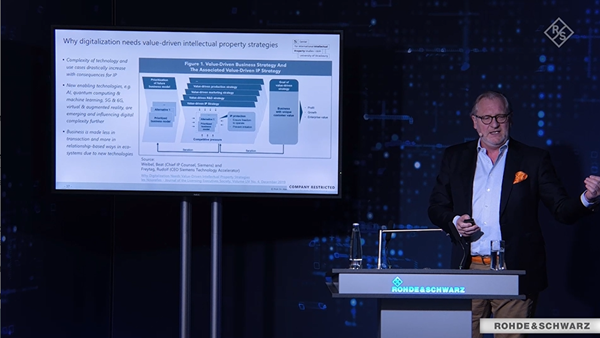Training at Rohde & Schwarz: The role of IP in the digital transformation
What role do patents play in the digital transformation, which we can see today and how are they used and made? What impact do they have on the economy? Digital transformation is the process by which companies embed technologies across their businesses to drive fundamental change. The benefits? Increased efficiency, greater business agility and, ultimately, the unlocking of new value for employees, customers and shareholders.
Many different paths lead to digital transformation and each organization’s journey will be unique. For example, a company might introduce AI or cloud computing to enhance its customer experience, or it might redesign its supply chain to make better use of machine learning. A company can even make spot-on predictions about the products customers will want in a few months’ time, then shift production to meet demand. In every case, though, starting a digital transformation journey requires a new mindset. It is a chance to reimagine how companies do things, often from the ground up.

We can see a dramatic increase in digital patents, for example at the EPO and worldwide. We are dealing here with three effects that change the role of patents in particular and IP in general in the digital transformation:
- The complexity of the technology and its applications is increasing dramatically (applications, use cases, customer journeys/experiences).
- Increasingly powerful enabling technologies such as AI, quantum computing, VR/AR, 3D printing etc. enable even more applications and further increase complexity.
- The business models made possible by these technologies are changing from transaction-oriented pipelines (value chains) to relationship-oriented ecosystems.
In 2019, Beat Weibel, Head of IP at Siemens, summarized the experiences and consequences made at that time. He said that, if you want to generate valuable IP, you first have to understand the business that is to be made as part of the innovation and then procure the IP that you need for this. So in the case of the IP strategy, not the technology lead, but the business lead is important in first place.
Protecting use cases with IP
Of course, Weibel is not alone with this way of thinking, he came up with the idea, which was already being implemented very successfully in many industries at this point in time. Here are a few examples:
- Spotify: User experience, e.g. the summary of a song suggestion, or platform explorability. Digital business models must be designed around digital use cases (customer needs, customer benefits, customer experience) in order to achieve the desired returns. This can be done top-down or bottom-up.
- Sonos: Volume setting feature in its dispute with Google. Customers are expecting simple and convenient UX, similar to the famous “Slide-to-Open” feature, which was part of the Apple versus Samsung case.
- Ford: The thinking that the use case, that is embedded in a business model counts, is cross-industry, further examples such as the automotive example Ford with the question what is a user of a vehicle allowed to do with it at all. E.g. if he does not pay his leasing installments, he can only use it for the drive to work in a certain area or the vehicle drives autonomously to the leasing company’s yard.
- Google: How do tech companies penetrate other industries? Google filed a patent for data trading, where the vehicle receives entertainment data (e.g. via Google Maps) and it gives the driver in exchange vehicle data.
This penetration into other industries goes very far. After various attempts costing billions (VW and CARIAD), the German car industry has now announced that it is giving up “software sovereignty”, because what counts is the user experience and it is not just in the business ecosystems of Big Tech already patented but also effective and in order to have apps and content (like available via Google Maps) etc. in the cars, you also need this software.
The same development exists in the B-to-B market, where we can look at the example of Siemens’ MRI business model “high throughput” or “pay per use“, which lead to different patents, because of the different exclusivity positions that are needed in these business models. What role does Siemens want to play for the factory equipment of the future? Siemens is developing an industry metaverse with NVIDIA and the patents should make the possible use cases exclusive.

What is the role of technology and R&D?
On the example of Philips Signify we can see what role technology and R&D play in these developments:
- A light bulb lasts no longer than a year with a burning time of 60 hours per week. A LED-bulb lives for 32 years with a burning time of 60 hours per week. This means the business model with the sale / retrofitting of broken light bulbs is largely dead.
- With the advent of LED technology, developed by different companies, there was a patent war with no winners – the whole industry lost and at the same time, sales of classic light bulbs fell to practically zero in a few years.
- The entire industry has agreed on a reciprocal licensing model so that all market players can produce LEDs and serve the market, however, LED sales are saturated due to the extremely long lifespan of LEDs.
- Philips has created the EnabLED license program for the application of light – these are patented use cases of LED light – with 180+ customer experiences and with 2,600+ patents that can be licensed depending on the additional hardware and software.
Signify for example makes 6.5 billion euros in sales with 10%+ operating profit of which 70% is generated from patented LED applications.
If you want to design patents with a business lead, then you need different processes and a different involvement of resources and experts in the company than with a technology lead:
- The IP department does not “wait” for invention disclosures, but aims to create exclusivity positions for customers in use cases and business models.
- An IP design process based on design thinking is used for this purpose, which runs in different phases and is characterized by an iterative approach (in contrast to strict stage-gate or waterfall processes).
- In the process and the corresponding workshops, IP, R&D and the market side work together in an integrative manner.
- The procedure of IP design has been industrially tested for over a decade, described in many case studies of successful innovation projects and is taught with the WIPO, the EPA, the EUIPO and worldwide with institutions of national innovation systems.
Here you can see the recording of the training give at Rohde & Schwarz:



